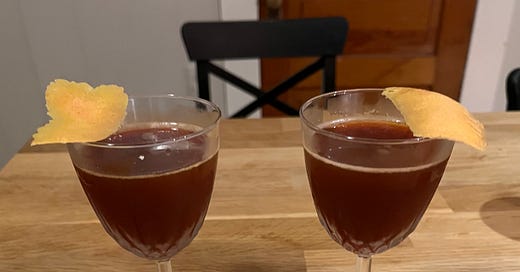I have seen horrific things. Martinis, Negronis, Manhattans — destroyed in a cocktail shaker. Every time I watch a bartender shake a spirit-forward cocktail like this, I die a little inside.
I get it. Shaking a cocktail is sexy, it’s a show, it looks like you’re actually making a drink. Stirring looks like something anyone could do at home. (Although, there’s a bit more rhyme and reason to stirring than many drinkers realize!) But just as important as knowing how to shake a cocktail is knowing when to do it — usually, when a drink has something that needs to be aerated, like citrus juice, milk, an egg, or espresso. If you shake a Martini or a Negroni, you might look cool, but you’ll be doing a disservice to your drink. Cocktails like that beg to be strong, smooth, and stirred, to emphasize the flavor of the spirits. Sorry, but James Bond had it wrong.
This drink throws out all that knowledge. A few drinks in Beta Cocktails ask you to stir citrus; only one is bold enough to ask you to shake pure alcohol. That’s the Fatigue, by Troy Sidle. He created this bizarre combination of whiskey, Angostura, and Maraschino liqueur as an end-of-shift drink for bartenders at Chicago’s Violet Hour — which was, funny enough, also ground zero for stirred citrus. And the first time I read the recipe, I thought the instruction was a typo! But shaking this one seems to be a way to tame the massive flavors at play just a little. (Plus, as we also know from the Heart of Glass, Sidle is more keen to play with texture than most bartenders.) “It tastes very different after you have straw tasted 150 citrus drinks and 100 brown and stirred,” head mixologist Toby Maloney has said, per Kindred Cocktails. “You have serious palate fatigue, thus the name, and you need something with HUGE flavors. Trust me this is really tasty at 2:30am on a Friday night.”
Somehow, I haven’t made a drink with Maraschino liqueur here yet. In short, it doesn’t taste like the cherries. It’s made from marasca cherries, but I find it to be sweet, light, and nutty (at least when it comes to Luxardo Maraschino, the gold standard).
Also nutty and sweet? Jack Daniel’s. I figured it was important to buy a bottle for this because Jack is such a specific product. Technically, it’s bourbon, with a corn-heavy mash bill. But it’s also a Tennessee whiskey, which means it goes through charcoal mellowing, a process of being filtered through charcoal chips. (This is also called the Lincoln County Process, and it wasn’t a legal requirement for Tennessee whiskey until 2013.) It doesn’t add any flavor to the whiskey — instead, like the name implies, it mellows out the flavors a bit and brings some notes other than grain to the forefront. In Jack’s case, those are things like peanuts, caramel, and bananas. It’s better than some dive-bar staples, but definitely not too good to toss into a cocktail shaker.
Fatigue1
1 ounce Jack Daniels
1 ounce Maraschino Liquor
1 ounce Angostura bitters
Shake and strain into a coupe. Garnish with a grapefruit twist.
By Troy Sidle
This drink is not mild — it’s a punch in the face. Shaking the drink definitely lightens it up and makes it sippable, but the flavors are strong. The bold Angostura and Maraschino combine to make a flavor that’s nutty, spicy, sweet, and medicinal. That sweetness was a surprise to me, since I expected this drink to be fairly bitter. There is a drying note from the Angostura too, but it’s very balanced overall, just intense. The Jack Daniel’s also adds to the sweetness, contributing caramel and banana notes. And even with just a grapefruit twist, I somehow get a grapefruit note here — maybe somewhere in the bitter Angostura? I also remember some odd, indescribable flavor in there that I wish I could explain better, but you’ll just have to try it for yourself.
I know, I got off-schedule again, but I’ll be wrapping up this week of cocktails tomorrow with two more bizarre shaken drinks.
From Beta Cocktails by Maksym Pazuniak and Kirk Estopinal, 2011.




